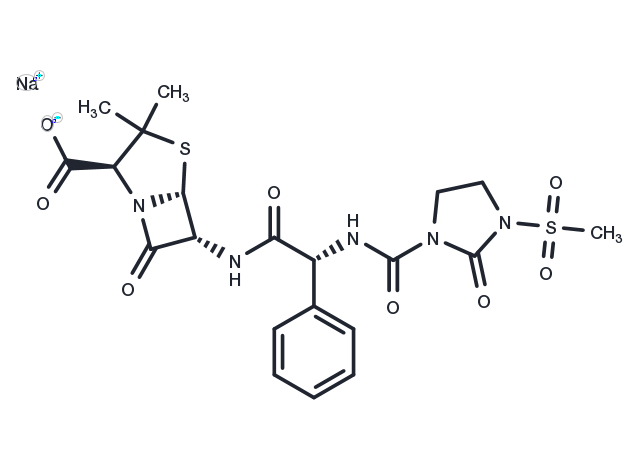Powder: -20°C for 3 years | In solvent: -80°C for 1 year


Mezlocillin Sodium (Baycipen) is a penicillin beta-lactam antibiotic used in the treatment of bacterial infections caused by susceptible, usually gram-positive, organisms.

| Pack Size | Availability | Price/USD | Quantity |
|---|---|---|---|
| 25 mg | In stock | $ 36.00 | |
| 50 mg | In stock | $ 51.00 | |
| 100 mg | In stock | $ 75.00 | |
| 200 mg | In stock | $ 108.00 | |
| 500 mg | In stock | $ 183.00 | |
| 1 mL * 10 mM (in DMSO) | In stock | $ 53.00 |


| Description | Mezlocillin Sodium (Baycipen) is a penicillin beta-lactam antibiotic used in the treatment of bacterial infections caused by susceptible, usually gram-positive, organisms. |
| In vitro | Mezlocillin sodium has in vitro activity against gram-positive and gram-negative aerobic and anaerobic bacteria. The bactericidal activity of mezlocillin results from the inhibition of cell wall synthesis and is mediated through mezlocillin binding to penicillin binding proteins (PBPs). Mezlocillin is stable against hydrolysis by a variety of beta-lactamases, including penicillinases, and cephalosporinases and extended spectrum beta-lactamases. Mezlocillin inhibits the third and last stage of bacterial cell wall synthesis by binding to specific penicillin-binding proteins (PBPs) located inside the bacterial cell wall. Cell lysis is then mediated by bacterial cell wall autolytic enzymes such as autolysins; it is possible that mezlocillin interferes with an autolysin inhibitor. Unlike many other penicillins, mezlocillin is either extensively metabolized or is subject to biliary excretion, as only about 50% of the dose is accounted for in normal urine. [1] |
| Synonyms | Baycipen |
| Molecular Weight | 561.56 |
| Formula | C21H25N5O8S2·Na |
| CAS No. | 42057-22-7 |
Powder: -20°C for 3 years | In solvent: -80°C for 1 year
H2O: 92 mg/mL (163.8 mM)
DMSO: 93 mg/mL (165.6 mM)
Ethanol: < 1 mg/mL (insoluble or slightly soluble)
You can also refer to dose conversion for different animals. More
bottom
Please see Inhibitor Handling Instructions for more frequently ask questions. Topics include: how to prepare stock solutions, how to store products, and cautions on cell-based assays & animal experiments, etc.
Mezlocillin Sodium 42057-22-7 Microbiology/Virology Antibiotic Antibacterial BAY-f 1353 bacterial infection gram-positive bacteria Mezlocillin Baycipen gram-negative bacteria Bacterial inhibit Inhibitor inhibitor
